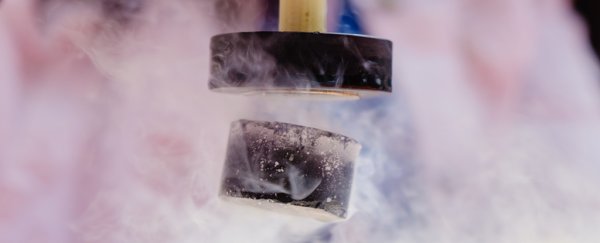Scientists have found evidence of superconductivity happening at temperatures and energy levels way above its normal boundaries – a finding which could one day go on to help revolutionise the design and workings of our electronics.
A superconductor material is one that can transfer electricity without resistance. In turn, this means the electricity travels through without energy losses, a phenomenon that would be of huge benefit everywhere from the gadgets in our pockets to larger electrical infrastructure.
The catch is that superconductors only start superconducting at very low temperatures.
To make it practical, scientists and engineers are interested in getting superconductivity happening at room temperature, and this new finding is another step in the right direction.
In the new study, researchers have observed Cooper pairs happening where they shouldn't be. A Cooper pair is when electrons snuggle together in pairs, close enough to pass through materials more easily (and without generating heat).
The discovery of electron pairing happening above the critical temperature that it normally occurs at won't be "crazy surprising" to the scientific community, according to physicist Doug Natelson from Rice University in Texas – but there's more.
"The thing that's more weird is that it looks like there are two different energy scales," says Natelson of the new result.
"There's a higher energy scale where the pairs form, and there's a lower energy scale where they all decide to join hands and act collectively and coherently, the behaviour that actually brings about superconductivity."
In other words, it looks like Cooper pairs can form at higher temperatures, but don't enter a state of coherence or start moving collectively – which is what creates superconductivity – until the lower temperatures are reached.
Scientists have previously hypothesised that this might be the case, but this is the first direct evidence for it, found in a superconductor called lanthanum strontium copper oxide (LSCO).
LSCO is a high-temperature superconductor, which works at higher-than-normal temperatures (though still extremely cold, hundreds of degrees below zero degrees Celsius).
Instead of just looking at the electrical current, the researchers analysed what's known as shot noise: variations in the flow of the electrical charge. Those variations didn't match what would be expected from a flow single electrons, suggesting pairing was happening at higher temperatures than it should be.
We're still a long way from room temperature superconductivity, but it appears that in LSCO at least, a high fraction of electrons are pairing up at temperatures well above the usual level needed for superconductivity – and that could be invaluable in future research.
The next step is to investigate how that pairing could lead to coherence, and from there to superconductivity.
"If that's true, and you've already got pairs at higher temperatures, the question is, 'can you also get coherence at those temperatures?'" says Natelson.
"Can you somehow convince [the electrons] to start their dance in the region known as the pseudogap, a phase space at higher temperatures and energy scales than the superconducting phase?"
We'll have to wait and see where the research takes us, but it's a pretty cool step.
The research has been published in Nature.
